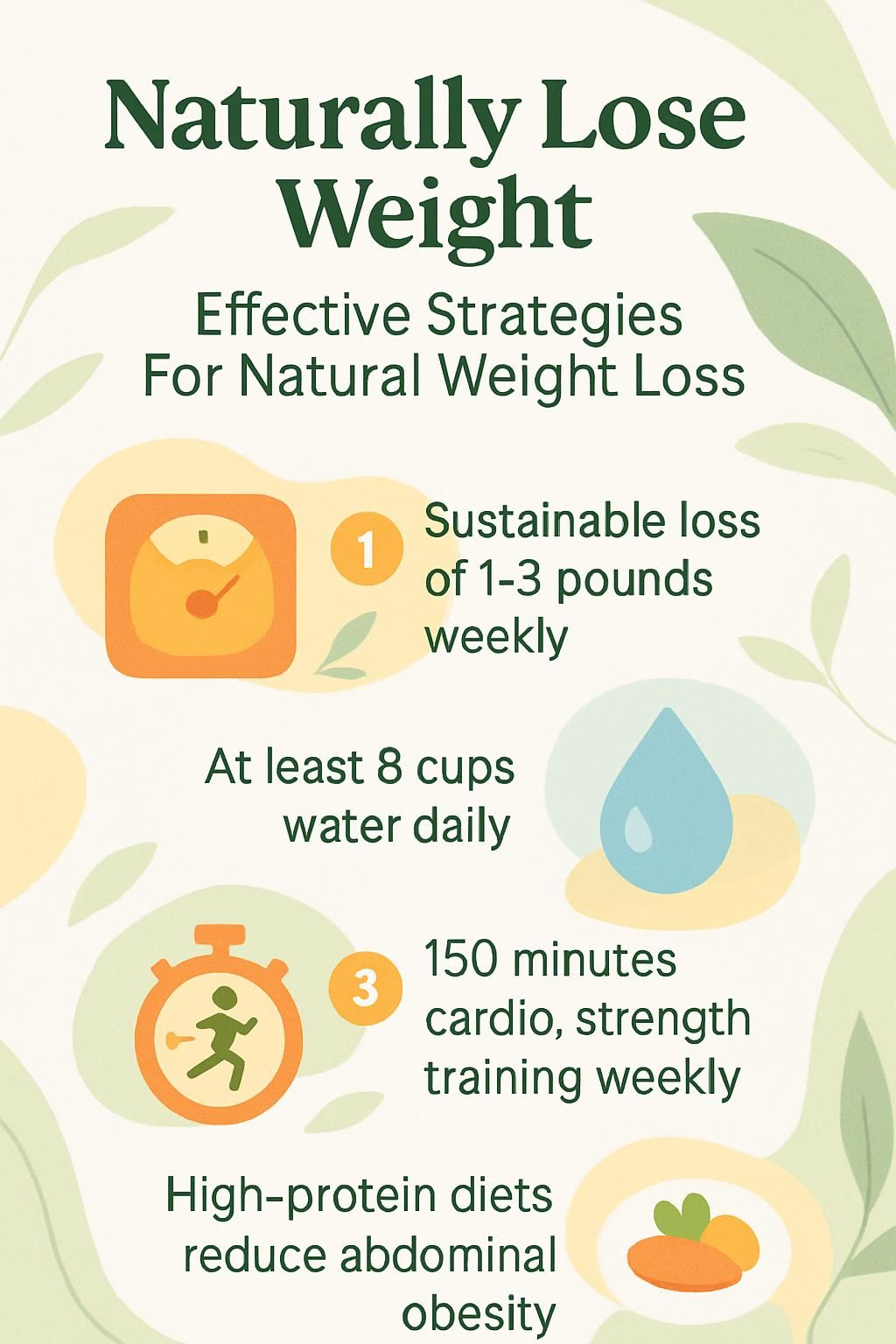Naturally Lose Weight: Effective Strategies For Natural Weight Loss
Our Nutrition Assistant AI Suite will transform your body. You will lose fat, get toned, and build muscle. Gain confidence and optimal health.
You want to lose weight and feel healthy, yet safe options can be hard to sort through. A natural approach focuses on real food, daily movement, and steady habits that lower health risks from processed foods and added sugar. These steps support weight loss and protect your heart and blood sugar.
This guide shares clear strategies, simple science, and everyday tips you can start now. You will find small changes that fit your life and help you keep results.
Key Takeaways
- Choose whole, single-ingredient foods and limit processed foods or sugary drinks, as Mayo Clinic advises, to support a steady loss of 1–2 pounds per week.
- Drink at least 8 cups of water daily. Replacing sweetened beverages lowers calorie intake and supports heart and metabolic health, based on Burls A, 2019.
- Combine 150 minutes of weekly cardio with strength training twice a week. This builds muscle and helps you burn more calories, according to Mayo Clinic Staff, 2022.
- Higher protein intake can reduce appetite, protect muscle during weight loss, and lower the risk of abdominal fat in many age groups.
- Gradual lifestyle shifts like mindful eating, good sleep, stress control, and tracking portions support long-term weight maintenance.

What Is Natural Weight Loss and Why Is Sustainability Important?

Natural weight loss means using healthy food, regular physical activity, and simple habits to lose fat and keep a healthy weight. Sustainable changes are easier to live with all year. They protect your health and help you avoid the cycle of regain.
What does it mean to lose weight naturally?
Losing weight naturally means adjusting your eating plan, exercise, and daily routines instead of relying on pills or fad diets. You center meals on vegetables, fruit, lean protein, healthy fats, and whole grains. You cut back on processed foods and sugary drinks, as experts at Healthline and Mayo Clinic recommend.
The CDC reports that gradual change helps you lose about 1 to 2 pounds per week safely. Exercise is part of the plan. Aerobic activities like brisk walking and cycling, plus strength training, support your metabolism and muscle mass. Swapping soda for water at meals can trim calories without feeling deprived.
Steady adjustments lead to results that last. Many supplements show mixed evidence and can cause side effects. Use them only with guidance from a healthcare professional.
Why is sustainability crucial for long-term weight loss?
Fast fixes may drop 10 pounds quickly, but the weight often comes back. Sustainable eating and activity patterns help you keep results. Mayo Clinic notes that people who build lasting habits have better long-term outcomes than people on strict short-term diets. Aim to lose 1–2 pounds per week so your body can adapt without intense hunger or fatigue.
Daily recommitment, small goals, and honest check-ins help habits stick through busy seasons and stress. Setbacks happen. Planning for them keeps you moving forward. Even small, repeatable changes in how you eat and move add up over time.
Long-term weight loss requires sustainable changes rather than quick fixes.
A gradual approach lowers the risk of regain and supports heart health, blood sugar control, and a healthy weight in adults. Food choices play a central role in losing excess body fat in a safe way.
Dietary Changes to Support Natural Weight Loss
Your daily food choices drive your results. Simple swaps and smart portions make it easier to eat well and control calories.
How can reducing processed foods and sugary drinks help?
Processed foods and sugary drinks often carry added sugar, unhealthy fats, and extra calories. Americans take in about 17 teaspoons of added sugar per day. High sugar intake ties to heart disease, type 2 diabetes, and some cancers.
Sodas, sweetened juices, flavored milks, and candy add liquid calories that do not fill you up. Cutting them reduces calories fast while keeping hunger in check. Studies show people who reduce processed foods tend to lose more weight than those who rely on packaged snacks and soda. Mayo Clinic guidance supports swapping processed items for fresh, healthy foods.
Why should you eat whole, single-ingredient foods?
Whole, single-ingredient foods offer the nutrients you need with fewer hidden sugars and fats. Meals built from lean meats, beans, nuts, vegetables, fruit, and whole grains help you feel full and support digestion. Research links a whole-food pattern with better weight control and less abdominal fat.
Mayo Clinic experts recommend these choices for steady weight loss because they make portion control easier. As Dr. Donald Hensrud of Mayo Clinic puts it:
Choosing whole foods is one of the best ways to improve health and promote long-term weight maintenance.
A simple example is swapping sugary cereal for oatmeal topped with berries or nuts. Short ingredient lists make planning easier and help you track what you eat.
How does increasing fiber improve digestion and weight loss?
Dietary fiber supports fullness and gut health. Water-soluble fiber absorbs water and expands in your stomach, which helps you feel full longer. That can lower calorie intake without ongoing hunger. Fruits, vegetables, legumes, and whole grains are strong sources.
Studies connect higher fiber intake to better digestion and weight loss over time. A diverse gut microbiome, supported by fiber, links to a lower risk of obesity. Increase fiber gradually, and drink water to reduce the chance of abdominal discomfort.
What are effective portion control strategies to limit calories?
Portion control is a proven Mayo Clinic strategy for weight loss. It helps prevent overeating, especially with calorie-dense foods like chocolate, bread, and nuts.
- Use smaller plates to reduce portions. Many people eat less without feeling deprived.
- Track your food in a diary or app. Research by Goldstein SP et al., 2019, shows tracking improves awareness and results.
- Avoid eating from large packages. Bigger containers can lead to mindless overeating.
- Serve plates in the kitchen instead of family-style to control amounts.
- Slow down. Chew more and give your body time to signal fullness.
- Prioritize protein at each meal to support fullness and lean muscle.
- Limit refined carbs that can spike insulin and drive cravings.
- Fill half your plate with vegetables. You add volume with very few calories.
- Watch portions at restaurants. Servings in the United States often exceed needs.
- Drink water before meals to reduce appetite and support a calorie deficit.
These steps help you lose excess weight while keeping a healthy relationship with food and portions.
How do protein-rich foods aid in natural weight loss?
Protein helps you feel full and supports your metabolism. Higher protein intake often reduces appetite, which can lower total calories across the day. Lean meats, eggs, beans, yogurt, and nuts are easy options. Eggs are especially helpful since they are filling and low in calories.
Protein also protects muscle during a calorie deficit, especially if you lift weights. Some people use whey protein to meet daily needs when food alone falls short. Studies across age groups show high-protein diets can support fat loss and better hunger control.
Hydration and Beverage Choices for Weight Loss
Smart drinks support weight loss like a backstage crew, quiet but powerful.
How much water should you drink daily for weight loss?
Aim for at least 8 cups, about 2 liters, of water each day. A study led by Burls A in 2019 found that higher water intake supports greater weight loss. Water before meals can reduce calories by increasing fullness. Replacing sugary drinks with water removes liquid calories that add up fast.
Water supports digestion and may help your metabolism work more efficiently. Keeping a reusable bottle nearby can cue you to sip more and cut snack urges. Mayo Clinic recommends water as your main drink for weight and health.
Why limit liquid calories from sugary drinks?
Sugar-sweetened drinks add many calories without filling you up. The average American consumes about 17 teaspoons of added sugar each day, much of it from beverages. These drinks raise the risk for obesity, heart disease, and type 2 diabetes.
Replacing them with water supports a low-carb or low-fat diet plan. Your body does not register fullness from liquid calories like it does from food, so intake can climb without notice. Cutting soft drinks and sweetened juices may also reduce blood pressure and support cardiovascular health.
What are the benefits of drinking unsweetened green tea and coffee?
Unsweetened green tea and black coffee are low-calorie drinks that may support fat loss. Green tea contains antioxidants called catechins that can boost metabolism. Matcha, a powdered form of green tea, is more concentrated and may offer stronger effects.
Black coffee can increase energy use and support workouts. Caffeine in both drinks can raise calorie burn and help you feel alert. Choose unsweetened versions to avoid added sugar. Reviews link these drinks with improved metabolism and reduced visceral fat over time.
Effective Exercise Strategies for Natural Weight Loss
Exercise turns your body into a more efficient calorie burner.
How does regular cardio exercise help burn fat?
Jogging, cycling, swimming, and brisk walking increase calorie burn and support heart health. Cardio helps create the calorie deficit you need to lose weight naturally. Aim for at least 150 minutes of moderate aerobic activity each week.
Cardio can also lower visceral fat, which is stored around organs like the liver and pancreas. This type of fat raises risk for hypertension and other chronic problems. Aerobic exercise supports healthy blood vessels and improves mood.
Many people see changes with a daily brisk walk, even before making big diet changes. Mayo Clinic recommends regular activity as a foundation for weight management.
Why include strength training to build muscle?
Strength training preserves and builds muscle while you lose fat. If you only cut calories, you may lose muscle along with fat. Lifting weights at least twice a week helps keep your resting metabolism higher, so you burn more calories all day.
Adding resistance work improves long-term weight maintenance. Pairing it with protein can support recovery and muscle growth. Clothes often fit better as muscle replaces fat.
– Mayo Clinic Staff, 2022, Strength Training: Get Stronger, Leaner, Healthier.
– Smith JJ et al., 2019, systematic review on diet plus resistance training outcomes.
How to find enjoyable physical activities for consistency?
Fun is fuel for consistency. If you enjoy your routine, you will stick with it.
- Test different options, like dancing, hiking, or team sports, to find activities you like.
- Add movement into your day. Take the stairs, walk during TV breaks, or do short home workouts.
- Match activities to your schedule. Try short walks after meals or weekend bike rides with family.
- Include cardio like swimming or cycling for efficient fat burn and heart health.
- Change your routine to keep it interesting and prevent boredom.
- Lift weights once or twice a week to build muscle and increase calorie use.
- Invite friends to classes or group walks. Social support helps you show up.
- Choose outdoor options, such as local park trails, for a mood boost.
- Listen to favorite music during workouts to increase enjoyment and time spent moving.
Pick two or three activities you can repeat each week. Consistency beats perfection.
Lifestyle Modifications to Enhance Weight Loss
Daily routines, like sleep and stress control, make weight loss quieter and easier to manage.
How does adequate sleep support metabolism?
Sleep keeps hunger hormones in balance. Too little sleep disrupts leptin and ghrelin, hormones that control appetite. You may crave more sugar and fat when you are tired.
A 2022 review by Liu S and colleagues linked poor sleep to higher carb cravings and harder weight control. Mayo Clinic encourages quality sleep to support calorie burning and recovery from workouts. If you are cutting calories or training hard, good sleep helps your body adapt.
What are effective ways to manage stress and avoid emotional eating?
Stress often pushes you to eat for comfort. Plan tools that calm your body and protect your habits.
- Set simple action goals, like an evening walk, to anchor your day.
- Track stress triggers with a journal or app. Link moods to food choices.
- Practice mindful eating. Pause to check hunger before you start and again mid-meal.
- Lean on supportive friends and family who encourage healthy choices.
- Interrupt stress with a short walk, deep breathing, or a fruit-and-nut snack.
- Reach out to a professional or use Mayo Clinic resources if stress feels heavy.
- Limit processed foods and sugary drinks. High sugar can amplify stress eating.
- Track mood swings alongside meals to spot patterns and plan ahead.
- Try calming herbal tea in the evening to reduce late snacking.
- Choose active breaks like a brisk walk to release tension without food.
These steps help you respond to emotions without turning to food. You stay in charge of your plan.
How can mindful eating help control portions?
Mindful eating helps you notice hunger and fullness signals. You slow down, enjoy flavors, and stop when you feel satisfied. Mayo Clinic encourages this approach because it leads to natural portion control.
Studies show mindful eaters often consume fewer calories and have fewer binge episodes. Try placing your fork down between bites and turning off screens at meals. You will likely feel full with less food.
Why avoid smoking and excessive alcohol for weight loss?
Smoking harms the lungs and damages blood vessels. It can reduce exercise capacity and disrupt healthy routines. Mayo Clinic warns that tobacco use can block progress toward a healthy lifestyle and weight.
Alcohol adds empty calories and lowers judgment, which can lead to overeating. Choosing water or calorie-free drinks supports a calorie deficit and keeps you on track. Limiting both smoking and heavy drinking supports your metabolism and heart health.
Natural Supplements That May Aid Weight Loss
Supplements are optional tools, not the main engine. Discuss them with a clinician before use.
How does green tea extract boost metabolism?
Green tea extract contains antioxidants called catechins that may increase fat oxidation, a process where your body uses fat for energy. Matcha, a powdered form, concentrates these compounds. Some studies suggest a small boost in calorie burn and appetite control.
Mayo Clinic notes that evidence for meaningful weight loss is mixed. High doses can cause nausea, bloating, diarrhea, or sleep issues. Start low and check how you feel.
Other options, like glucomannan or caffeine, have different mechanisms and safety notes. Learn how they work before deciding.
What is glucomannan and how does it control appetite?
Glucomannan is a soluble fiber from the konjac plant. It absorbs water and expands in your stomach, delaying gastric emptying. You may feel full longer and eat fewer calories.
It appears in some weight loss supplements and fiber blends. Evidence is mixed, and Mayo Clinic reports insufficient proof for significant effects. Take it with plenty of water to reduce choking risk. Some people experience gas, bloating, or constipation.
A small serving mixed into yogurt can help with morning fullness. Monitor your body’s response and adjust.
How can caffeine increase energy expenditure?
Caffeine stimulates the central nervous system, which can raise energy expenditure through thermogenesis, your body’s heat production. You can find caffeine in coffee, tea, and some protein or pre-workout products.
Research suggests a short-term bump in calorie burn of about 3 to 11 percent after intake. A cup of coffee before exercise may feel energizing and support fat use. Do not overdo it, since too much caffeine can cause insomnia or a rapid heartbeat. Many fat-burn products add caffeine, sometimes with other stimulants like ephedrine from the Ephedra plant. These combinations can be unsafe.
(Study example: The Effect of Caffeine on Energy Expenditure, 2018, Journal of Nutrition Research.)
Behavioral Changes to Support Weight Loss
Small habits lower friction and make healthy choices the easy choices.
How does eating more slowly improve fullness?
Your body needs time to release hormones that signal fullness. Fast eating can outpace those signals, which leads to larger portions before you feel satisfied. Studies show slow eating can increase fullness hormones and reduce calorie intake per meal.
Try setting your utensil down between bites or using smaller utensils. Many people find cravings drop when they leave the table satisfied.
Why use smaller plates to control portions?
Smaller plates make portions look larger, which can help you feel content with less food. A 2012 study found people served themselves 9 to 31 percent less on smaller plates. Healthline lists this as a practical strategy for natural weight loss.
This simple cue works at home and when dining out. It reduces calories without extra willpower.
How can brushing your teeth after meals reduce snacking?
Brushing leaves a minty taste that clashes with most snacks. That taste, plus the mental signal that the meal is over, reduces grazing. A 2024 study led by Cho Y linked post-meal brushing to less snacking and lower obesity rates, especially in teens.
Try brushing after dinner. You may find dessert cravings fade within minutes.
Benefits of Probiotics for Weight Management
A healthy gut can support appetite control and energy balance.
How does gut health influence weight loss?
Gut bacteria help regulate appetite and how you process calories. Research by Breton J et al., 2022, shows a link between a balanced gut microbiome and lower obesity risk. Probiotic foods and supplements may support this balance.
Better digestion and nutrient absorption can make healthy eating feel easier. Many people notice less bloating and more regularity when they add probiotic foods.
Which yogurt and fermented foods support a healthy gut?
Choose yogurt with live active cultures and minimal added sugar. Low-fat, unsweetened yogurt gives probiotics without extra calories. Kefir, a fermented milk drink, usually contains even more strains.
Non-dairy options include sauerkraut, kimchi, and miso. These foods offer beneficial bacteria and fiber for digestion. A small serving with lunch or dinner can improve gut balance within weeks.
Intermittent Fasting as a Natural Weight Loss Method
Time creates structure, and structure can guide better choices.
What are the benefits of time-restricted eating?
Time-restricted eating limits the hours you eat, which often lowers daily calories. A common pattern is 16:8, where you eat during an 8-hour window and fast for 16 hours. Many people snack less at night and find it easier to hit calorie goals.
Studies show this method can support fat loss and improve metabolic markers. It may also steady appetite hormones, so you feel full with normal portions.
What are popular intermittent fasting methods to try?
Several fasting patterns can support natural weight loss. Pick one that matches your routine.
- 16:8 method: eat within an 8-hour window, such as noon to 8 p.m., and fast for 16 hours.
- 5:2 diet: eat normal calories on five days and limit calories, about 500–600, on two nonconsecutive days.
- Eat-stop-eat: one or two 24-hour fasts per week, such as dinner to dinner.
- Alternate-day fasting: regular eating one day, about 500 calories the next. Varady KA et al., 2022, found benefits for weight and metabolic health.
- Warrior Diet: small amounts of fruits or vegetables during the day with one larger meal at night within four hours.
- Adjust the schedule to your needs. Consistency matters more than the exact method.
- Pair fasting with healthy foods and hydration. Water and green tea can help manage hunger.
Review these options with a clinician if you have medical conditions or take medications.
Tips for Long-Term Weight Loss Success
Lasting weight loss comes from repeatable habits and simple systems.
How to create a sustainable healthy lifestyle?
Build your plan on whole foods, daily movement, and enough sleep. Increase fiber for fullness and gut health. Mayo Clinic suggests at least 150 minutes of moderate exercise weekly to support weight loss and heart health.
Expect slips and plan for them. If you overeat, return to your next normal meal. Many people find that keeping a simple food log reveals small changes that make a big difference.
How to track progress without obsessing over the scale?
Use a food diary, step counter, or weekly photos to track trends. Goldstein SP et al., 2019, found that consistent tracking supports progress. Set action-based goals, like cooking three healthy dinners this week, not just number goals.
Celebrate non-scale wins, such as better energy, improved fitness, or looser clothes. Make adjustments based on patterns instead of reacting to one weigh-in.
Why surround yourself with health-focused people?
Your circle shapes your habits. Supportive friends provide motivation and accountability, as Mayo Clinic notes. Positive company can reduce stress and help you follow through.
Shared activities, like weekend walks or group classes, make healthy choices social and fun. Many people stick with change longer when they feel part of a team working toward similar goals.
Common FAQs About Natural Weight Loss
Quick answers can clear common roadblocks and keep you moving.
How much weight can you naturally lose in one month?
A safe pace is about 1 to 2 pounds per week, or 4 to 8 pounds per month. Mayo Clinic and many studies support this range for sustainable results. Aiming far higher increases the chance of muscle loss, fatigue, and regain.
Set realistic goals, like losing about five percent of your starting weight over several months. Results vary based on activity level, food choices, sleep, and stress. Steady habits help you keep what you lose.
Are natural weight loss methods safe for everyone?
Most natural methods are safe for healthy adults. People with medical conditions, such as diabetes or heart disease, need personalized guidance. Some supplements contain hidden drugs or risky stimulants. The FDA has warned about contaminated weight loss products since 2017.
Intermittent fasting is not right for everyone, including those who are pregnant or have certain metabolic conditions. Speak with a healthcare professional before starting a new plan, especially if you take medications or have a chronic illness.
Conclusion
Natural weight loss works best with real food, steady activity, smart hydration, and sleep. Focus on whole foods, lean protein, and fiber to feel full. Limit liquid calories. Build routines you can keep.
Progress grows from small, consistent steps. Choose one change to start today, such as water with meals or a 20-minute walk. With patience and practice, you can reach a healthy weight and maintain it.
Medical disclaimer: This content is educational and not a substitute for personalized medical advice. Consult your clinician if you have health conditions, take medications, or need guidance on diet, supplements, or exercise.
FAQs
1. What are effective strategies for natural weight loss?
Effective strategies include eating whole foods, increasing daily movement, drinking water before meals, and getting enough sleep. Studies show that people who eat more fruits and vegetables tend to lose weight faster than those who do not.
2. How does tracking food intake help with losing weight naturally?
Tracking what you eat helps you notice patterns in your diet. Research shows that keeping a food journal can double the amount of weight lost compared to not tracking at all.
3. Are there risks with rapid natural weight loss methods?
Losing too much weight quickly may lead to muscle loss or nutritional gaps according to medical studies. Safe rates are about one to two pounds per week using balanced nutrition and regular activity.
4. Can personal experience support evidence-based approaches for natural weight loss?
Personal stories often highlight how small changes like walking after dinner or swapping soda for water make a difference over time; these habits align with scientific findings on sustainable results.
Summary: Natural weight loss works best when combining proven methods such as healthy eating, physical activity, mindful habits, and steady progress supported by both research data and real-life experiences.







